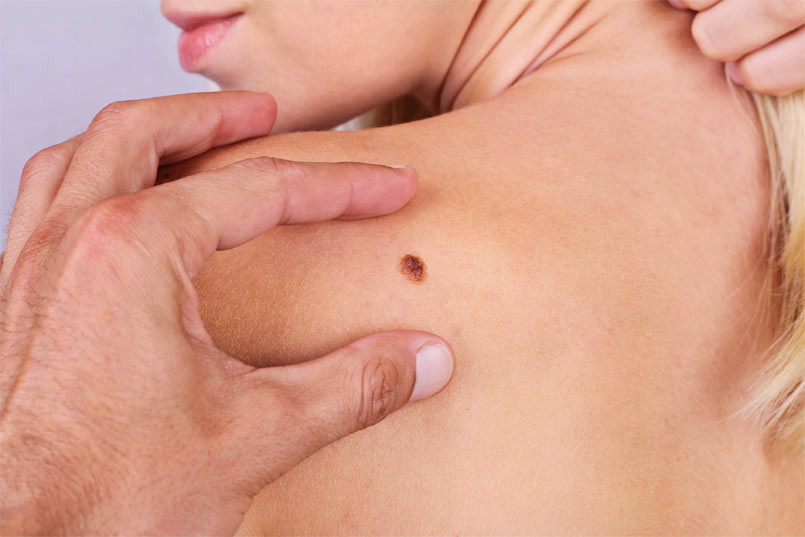Cancer of any kind can be scary, and worrying about a mole that has changed in shape or appearance, or is bleeding can be a difficult time. Many of us have concerns about contracting cancer of the skin, but are often to nervous to approach our medical care provider for advice or a diagnosis. In this blog, we look at some of the most common concerns out patients have about skin cancer.
What is skin cancer?
Skin cancer is the uncontrolled growth of abnormal skin cells. It occurs when un-repaired DNA damage to skin cells triggers mutations that multiply rapidly and form malignant tumors. These types of abnormal skin cells are most often caused by increased or intense exposure to UV radiation from the sun or by using tanning beds.
What are the symptoms of skin cancer?
Unlike some other cancers, skin cancers can usually be identified on the skin by presence of new or unusual moles. A mole which changes shape, size or even starts to bleed could be a sign of skin cancer. Because the early symptoms can be seen on the outside of the body, most skin cancers can be caught early enough to be treated successfully.
Not all skin cancers look the same and can be identified by a variety of symptoms including a new growth or mole, a sore that won’t heal or even just a change in an existing growth.
Sometimes skin cancer is painful, but usually it doesn’t cause any pain that would lead you to have it investigated. Any new growths that appear on your skin should be tested and monitored if you are concerned about their appearance. Of course, not all chances to your skin are a sign of cancer, but it would be best to report anything unusual or lingering to your health care provider, who may refer you to a dermatologist for further investigation.
What are the differences between benign and malignant cancer?
If you do have any changes to your skin investigated by a healthcare professional, it can be a worrying time waiting to receive a diagnosis. Like many other tests for cancer, your doctor will look for abnormal cells and test them accordingly. You will be told whether or not your growths are benign or malignant before the doctor offers you a course of treatment, if one is required.
Benign growths are not cancerous. They are rarely life threatening and can usually be removed and will not grow back. They do not pose any risk to the tissues around them and will not spread to other parts of the body.
Malignant growths are cancerous and are more serious than benign growths. They will need to be removed and you will need to follow a specific course of treatment to prevent the cancerous cells from invading the surrounding tissue or spreading to other parts of the body. Malignant growths can grow back, so continued monitoring of your skin is vitally important after a cancer diagnosis.
What are the risks associated with developing skin cancer?
These days, many people understand just how dangerous prolonged exposure to the sun can be. Wearing a high factor sun screen and staying out of the sun when you can should prevent any irreparable damage to your skin.
Ultraviolet radiation is not limited to just the sun however, as UV radiation is also present in sunlamps, tanning beds and tanning booths. A person’s risk of skin cancer is related to lifetime exposure to UV radiation. Most skin cancer appears after age 50, but the sun damages the skin from an early age.
People with fair skin or freckles, or have red or blonde hair are at greater risk of skin cancer, but even darker skinned people can contract skin cancer. Geographically, areas in the South like Texas and Florida get more UV radiation than areas in the North of the country. Although, it is important to remember that UV radiation is present even in cold weather or on a cloudy day.
A personal history or a family history of skin cancer can also increase your risk as can certain types of pre-existing skin conditions, diseases or immune suppressing medications.
How can skin cancer be prevented?
The best way to prevent skin cancer is to protect yourself and your family from the sun. You should limit your time in sunlight and always wear a sunscreen. Even though many skin cancers don’t resent until patients are well into their adult years, children should be protected at all times to limit any form of damage to their skin.
The easiest ways to avoid the dangers of UV radiation are to avoid the midday sun, wear a sunscreen with UVA and UVB filters, wear long sleeves and long pants and always wear a hat and sunglasses with UV protective lenses. You should also avoid tanning booths and sunlamps.
If you are concerned about the health of your skin, or have a growth that you would like to have investigated, our MelaFind® procedure is the first CE Mark and FDA approved system that identifies over 95% of melanomas.
Call us today on 941-254-2321 to book an appointment with us.





